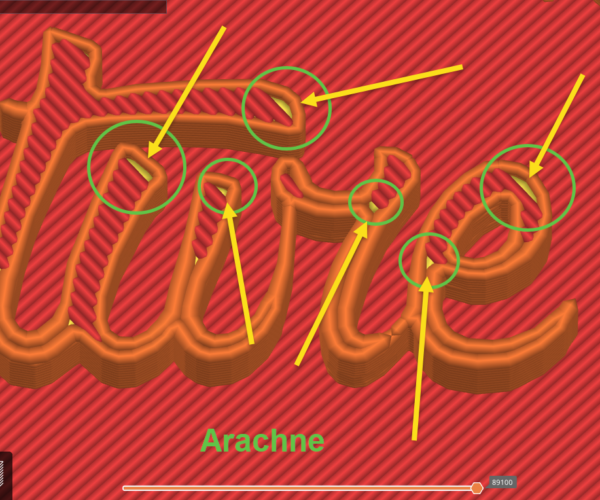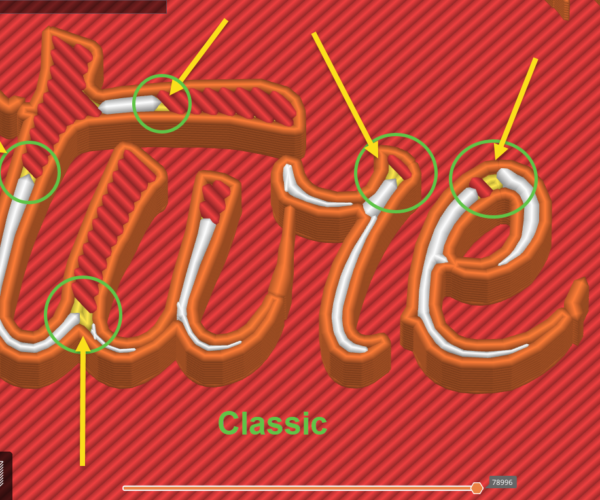Not perfect fill of small uneven surfaces
Hello,
I started to print non mechanical parts (e.g. non squared or even surfaces) and I noticed that either the Classic infill than Arachne leave empty areas when they fill small areas of an uneven part, even if Detect thin walls is set and Fill gaps is set.
You can see below how Arachne is filling some areas.
The highlighted areas with circles are just some points of the print. The yellow that is visible is the below layer and that point is not covered by any extrusion. This cause tiny holes, that especially in multicolour prints are very noticeable. The fill is done always in the same way, so the tiny hole is spread down through layers always in the same point.
Same thing, but done in different way is done by the Classic filler.
I could say that the Classic fills better than Arachne in some points but not in all.
However both them leave still holes.
- Is there any additional parameters to force the total infill ?
May be I will open an issue on github.
Regards
Excellent illustrations; they demonstrate exactly why your requirement is impossible.
Notice how all the spaces are smaller than one extrusion?
Whilst you can play around with orientation to increase resolution and choose founts designed for low precision your baseline is the extrusion width of your nozzle. With a default 0.4mm nozzle it's 0.45mm.
This is a variation of the frequent misguided complaints when impossibly thin walls fail or parts are "inaccurate" by a few tenths of a millimetre.
For ordinary text taking no special measures the smallest for decent reproduction is around 1cm high, about 28 point text. A rough estimate puts your decorative fount at around 10 point, for acceptable decorative reproduction you should stay above 36 point.
Traditional printers (people, not machines) talk in 'lines per inch', the number of adjacent black/white lines the machine can fit in one inch - cheaper magazines are printed at around 150 lpi. If you divide one inch by 0.45mm extrusion width you get 56 positions allowing 28 lpi - meaning the smallest readable text must be roughly 6 times larger than magazine small-print.
So: the simple answer to your question is, there are gaps because you have not left enough room to fit anything in.
Cheerio,
RE:
I was supposing it. 😉 That was printed with 0.25 nozzle, and some letters details have been printed at a thickness of 0.65 mm, so it worked very well enough.
My point was caused by the fact that arachne that is able to vary the extrusion width (more or less than 0.28) would be able to fill better, and it could be still improved. 😎
In the above Arachne picture, you can clearly see that on the r letter, it enlarged the perimeter extrusion to cover the equivalent of two lines, but it did not used this technique on the top of the u letter. If it were, then the top u letter would have no gap. 😊
Same fact for the Classic: on the above picture you see in white feature, the additional fills extrusion by the Gap fill parameter. You can clearly see on the bottom of the e letter, and on the bottom of the u letter, that the additional white fill is smaller than the standard extrusion size (that is 0.28 in this print) 😊
So there is still space to improve Prusaslicer...
Regards

